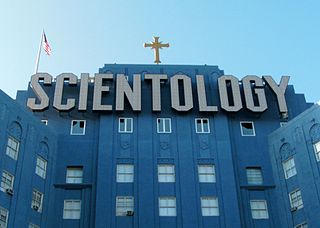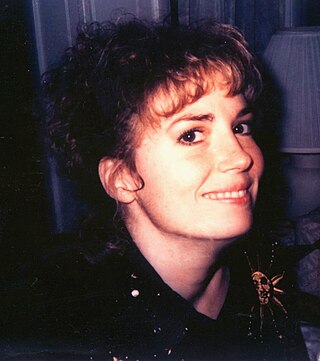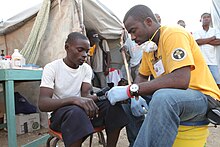
Dianetics is a set of pseudoscientific ideas and practices regarding the metaphysical relationship between the mind and body created by science fiction writer and Scientology founder L. Ron Hubbard. Dianetics is practiced by followers of Scientology and the Nation of Islam.

Narconon International is a Scientology organization which promotes the theories of founder L. Ron Hubbard regarding substance abuse treatment and addiction. Its parent company is the Association for Better Living and Education (ABLE), which is owned and controlled by the Church of Scientology. Headquartered in Hollywood, California, United States, Narconon operates several dozen residential centers worldwide, chiefly in the U.S. and western Europe. The organization was formed in 1966 by Scientologist William Benitez with Hubbard's help, and was incorporated in 1970.

The Church of Scientology maintains a wide variety of beliefs and practices. The core belief holds that a human is an immortal, spiritual being (thetan) that is resident in a physical body. The thetan has had innumerable past lives, some of which, preceding the thetan's arrival on Earth, were lived in extraterrestrial cultures. Based on case studies at advanced levels, it is predicted that any Scientologist undergoing auditing will eventually come across and recount a common series of past-life events.

Since its inception in 1954, the Church of Scientology has been involved in a number of controversies, including its stance on psychiatry, Scientology's legitimacy as a religion, the Church's aggressive attitude in dealing with its perceived enemies and critics, allegations of mistreatment of members, and predatory financial practices; for example, the high cost of religious training:191 and perceived exploitative practices. When mainstream media outlets have reported alleged abuses, representatives of the church have tended to deny such allegations.
The Purification Rundown, also known as the Purif or the Hubbard Method, is a pseudoscientific procedure that advocates of Scientology claim is a detoxification program. There is no evidence for its efficacy in detoxification, and significant evidence from clinicians that it is dangerous. It involves heat exposure for up to 5 hours a day and can exceed 4 weeks in length. It can potentially cause heatstroke damage, which includes brain injury, heart problems, organ failure, and death. It was developed by Scientology's founder L. Ron Hubbard and used by the Church of Scientology as an introductory service. Numerous individuals have been hospitalised as a result of taking part in the process.

The E-meter, originally the electropsychometer, is an electronic device for displaying the electrodermal activity (EDA) of a human being. It is used for auditing in Scientology and divergent groups. The efficacy and legitimacy of Scientology's use of the E-meter has been subject to extensive litigation and in accordance with a federal court order, the Church of Scientology publishes disclaimers declaring that the E-meter "by itself does nothing", is incapable of improving health, and is used specifically for spiritual purposes.

In Dianetics and Scientology, auditing is a sequence of actions whereby the "auditor" takes an individual through times in their current or past lives with the purpose of ridding the individual of negative influences from past events or behaviors. According to practitioners, auditing is meant to bring the individual to "Clear" status; thus, an individual being audited is known as a "preclear" or PC.

Scientology and its perspectives on sexual orientation are based on the writings of L. Ron Hubbard, the founder of the Church of Scientology. His statements about homosexuality have led critics to assert that Scientology promotes homophobia, though these allegations are disputed by some Scientologists.

The Oxford Capacity Analysis (OCA), also known as the American Personality Analysis, is a list of questions which is advertised as being a personality test and that is administered for free by the Church of Scientology as part of its recruitment process. The organization offers the test online, at its local sites, and sometimes at local fairs, carnivals, and in other public settings. It has no relation to the University of Oxford, although the name may have been chosen to imply a link.
In Dianetics and Scientology, Clear is a status afforded to followers by the Scientology organization, or by other Scientologists, after they complete certain activities. It is one of the major ostensible "states" practitioners strive to reach on their way up what the Scientologists call the Bridge to Total Freedom. Scientology followers are given the status of Clear when a person is deemed to be free of the influence of engrams – supposed unwanted emotions or painful traumas which Scientology claims are not readily available to the conscious mind. Scientologists believe that human beings accumulate anxieties, psychosomatic illnesses, and aberration due to receiving engrams throughout their current or past lives, and that by applying Dianetics, every single person can obtain the status of Clear.

The Church of Scientology is a group of interconnected corporate entities and other organizations devoted to the practice, administration and dissemination of Scientology, which is variously defined as a cult, a business, or a new religious movement. The movement has been the subject of a number of controversies, and the Church of Scientology has been described by government inquiries, international parliamentary bodies, scholars, law lords, and numerous superior court judgements as both a dangerous cult and a manipulative profit-making business. In 1979, several executives of the organization were convicted and imprisoned for multiple offenses by a U.S. Federal Court. The Church of Scientology itself was convicted of fraud by a French court in 2009, a decision upheld by the supreme Court of Cassation in 2013. The German government classifies Scientology as an unconstitutional sect. In France, it has been classified as a dangerous cult. In some countries, it has attained legal recognition as a religion.

Since the founding of the Church of Scientology in 1954 by L. Ron Hubbard, the relationship between Scientology and psychiatry has been dominated by strong opposition by the organization against the medical specialty of psychiatry and of psychology with themes relating to this opposition occurring repeatedly throughout Scientology literature and doctrine. According to the Church of Scientology, psychiatry has a long history of improper and abusive care. The group's views have been disputed, criticized, and condemned by experts in the medical and scientific community and have been a source of public controversy.

Scientology ethics and justice are a collection of policies and procedures by L. Ron Hubbard and used by the Church of Scientology. Scientology defines ethics as "the actions an individual takes on himself", and justice as "the action taken on the individual by the group when he fails to take these actions himself". The body of writings include techniques and policies of moral choices, and the rules of conduct to be followed by scientologists.
When the individual fails to put in his own ethics, the group takes action against him and this is called justice.
The Church of Scientology publicly classifies itself as a religion, but scholars and other observers regard it as a business, because the organization operates more like a for-profit business than a religious institution. Some scholars of sociology working in religious studies consider it a new religious movement. Overall, as stated by Stephen A. Kent, Scientology can be seen as a "multi-faceted transnational corporation that has religion as only one of its many components. Other components include political aspirations, business ventures, cultural productions, pseudo-medical practices, pseudo-psychiatric claims, and, an alternative family structure."
A Touch Assist is a Scientology procedure purported to heal illness or injury. It is one of many such Assists.

The Alaska Mental Health Enabling Act of 1956 was an Act of Congress passed to improve mental health care in the United States territory of Alaska. It became the focus of a major political controversy after opponents nicknamed it the "Siberia Bill" and denounced it as being part of a communist plot to hospitalize and brainwash Americans. Campaigners asserted that it was part of an international Jewish, Roman Catholic or psychiatric conspiracy intended to establish United Nations-run concentration camps in the United States.

Scientology is a set of beliefs and practices invented by the American author L. Ron Hubbard, and an associated movement. It is variously defined as a cult, a business, or a new religious movement. Hubbard initially developed a set of ideas that he called Dianetics, which he represented as a form of therapy. An organization that he established in 1950 to promote it went bankrupt, and Hubbard lost the rights to his book Dianetics in 1952. He then recharacterized his ideas as a religion, likely for tax purposes, and renamed them Scientology. By 1954 he had regained the rights to Dianetics and founded the Church of Scientology, which remains the largest organization promoting Scientology. There are practitioners independent of the Church, in what is called the Free Zone. Estimates put the number of Scientologists at under 40,000 worldwide.

The Citizens Commission on Human Rights International (CCHR) is a nonprofit organization established in 1969 by the Church of Scientology and psychiatrist Thomas Szasz, headquartered in Los Angeles, California. Its stated mission is to "eradicate abuses committed under the guise of mental health and enact patient and consumer protections." Many critics regard it as a Scientology front group whose purpose is to push the organization's anti-psychiatric agenda.

Scientology was founded in the United States by science fiction author L. Ron Hubbard and is now practiced in many other countries.

Scientology front groups are those groups named or operated in such a way as to disguise their association with the Church of Scientology (COS). COS uses front groups to promote its interests in politics, to make itself appear legitimate, and to recruit. Many of the groups are founded on pseudoscience, named disingenuously, and underplay their links to Scientology.











